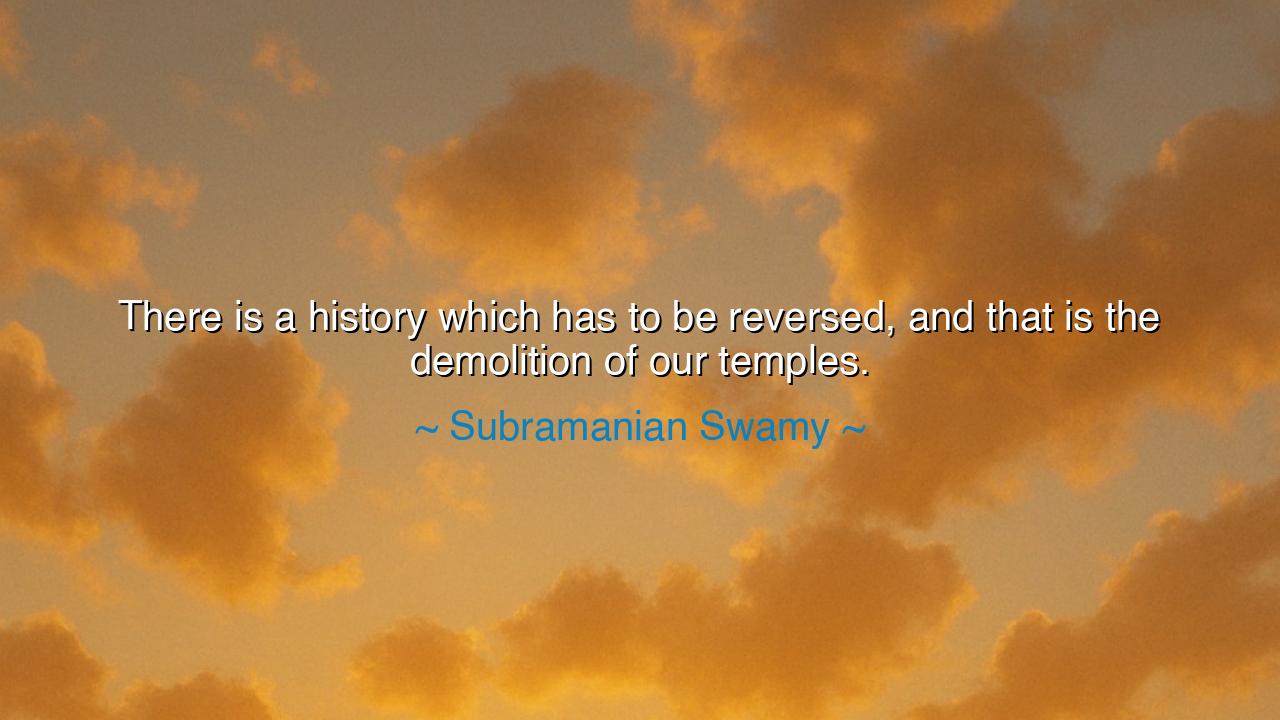
There is a history which has to be reversed, and that is the
There is a history which has to be reversed, and that is the demolition of our temples.






In the stirring words of the modern age, Subramanian Swamy, scholar and statesman, proclaimed: “There is a history which has to be reversed, and that is the demolition of our temples.” These words are not merely political or cultural; they are a cry from the soul of a civilization. They speak to the memory of a people whose sanctuaries — both of stone and of spirit — were once torn down by invaders and time alike. In them resounds the eternal human yearning to restore what was sacred, to heal the wounds of history, and to reawaken the divine centers of identity that lie buried beneath centuries of dust.
When Swamy speaks of temples, he speaks not only of physical structures, but of symbols — of the spiritual heart of a nation, of its philosophy, its art, and its continuity through the ages. The demolition of temples is not merely the destruction of buildings; it is the attempt to shatter a people’s faith, to sever the bridge between past and future. For in the ancient world, a temple was more than stone — it was the dwelling of consciousness, the meeting point between the mortal and the divine. To tear it down was to unseat the gods from human life. To rebuild it, therefore, is not vengeance — it is resurrection.
The origin of Swamy’s words lies in the history of India, where, during centuries of foreign conquest, countless temples were desecrated and replaced with monuments alien to the spirit of the land. The sacred cities — Kashi, Mathura, Ayodhya — bore witness to devastation, yet beneath the rubble, faith endured. Generations passed, but the memory of the sanctuaries remained, like embers beneath ashes, waiting for the breath of time to rekindle them. In invoking this quote, Swamy gives voice to that ancient longing — to reverse the tide of destruction, not merely by rebuilding stones, but by restoring dignity, continuity, and pride to a people whose sacred geography had been scarred.
History bears many such wounds, and with them, lessons. The Parthenon of Athens was once a radiant shrine to Athena, until it was defaced and converted into other uses through the ages. Yet centuries later, it stands again, reclaimed as the symbol of Greek identity — not as an act of hatred, but of reverence. Similarly, the Jewish people, after millennia of exile, restored their homeland and rebuilt their spiritual centers, guided not by conquest, but by remembrance and unity. So too, Swamy’s words echo that universal truth: that a civilization which forgets its temples — its sacred roots — loses the rhythm of its soul. To reverse history, in this sense, is to remember who we are.
But his message goes beyond stone and architecture. The temples within — our moral integrity, our cultural memory, our spiritual awareness — have also been neglected, eroded by apathy and imitation. These too must be rebuilt. For every man and woman carries within them a sanctum — a place of truth and devotion — and when that inner temple is neglected, society itself falls into darkness. The call to rebuild temples is also a call to rebuild character: to restore faith where doubt has crept in, to rekindle discipline where decay has set in, to raise once more the pillars of compassion, wisdom, and strength within the human heart.
It is not enough, then, to mourn what was lost; one must act. The past cannot be undone, but it can be redeemed. As the ancients taught, destruction is not the end, but the beginning of renewal. The temple that falls gives rise to the temple reborn, stronger and more radiant, carved not only from stone but from conviction. In this way, to “reverse history” is not to rewrite it, but to heal it — to transform suffering into strength, humiliation into pride, and silence into song.
Therefore, O inheritors of an ancient flame, take these words to heart: the temples of your ancestors may have fallen, but the spirit that built them has not. It lives in you. Whether you restore a monument, a tradition, or a forgotten virtue, you are rebuilding the link between heaven and earth. Let your work, your learning, your compassion, and your courage be your offerings to that sacred restoration. For when we rebuild what is holy — within and without — we do not merely honor the past; we reclaim the future.
Thus, the wisdom of Subramanian Swamy stands as both remembrance and commandment: the demolition of our temples was the wound of history — the rebuilding of them is its redemption. Let every generation, therefore, rise to this noble task — not with anger, but with resolve and reverence — until the sanctuaries of stone and spirit alike once again resound with the music of the eternal.






AAdministratorAdministrator
Welcome, honored guests. Please leave a comment, we will respond soon